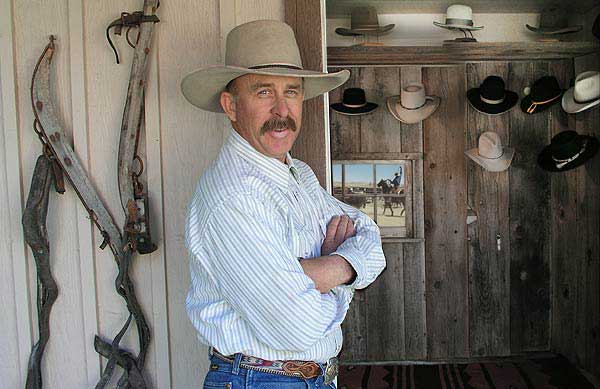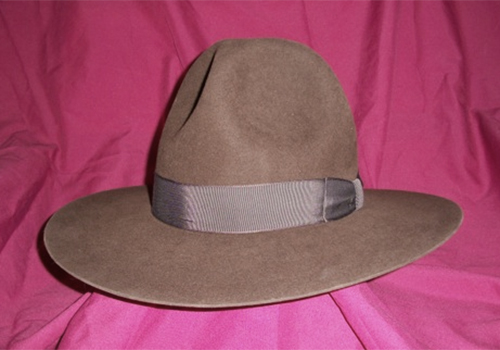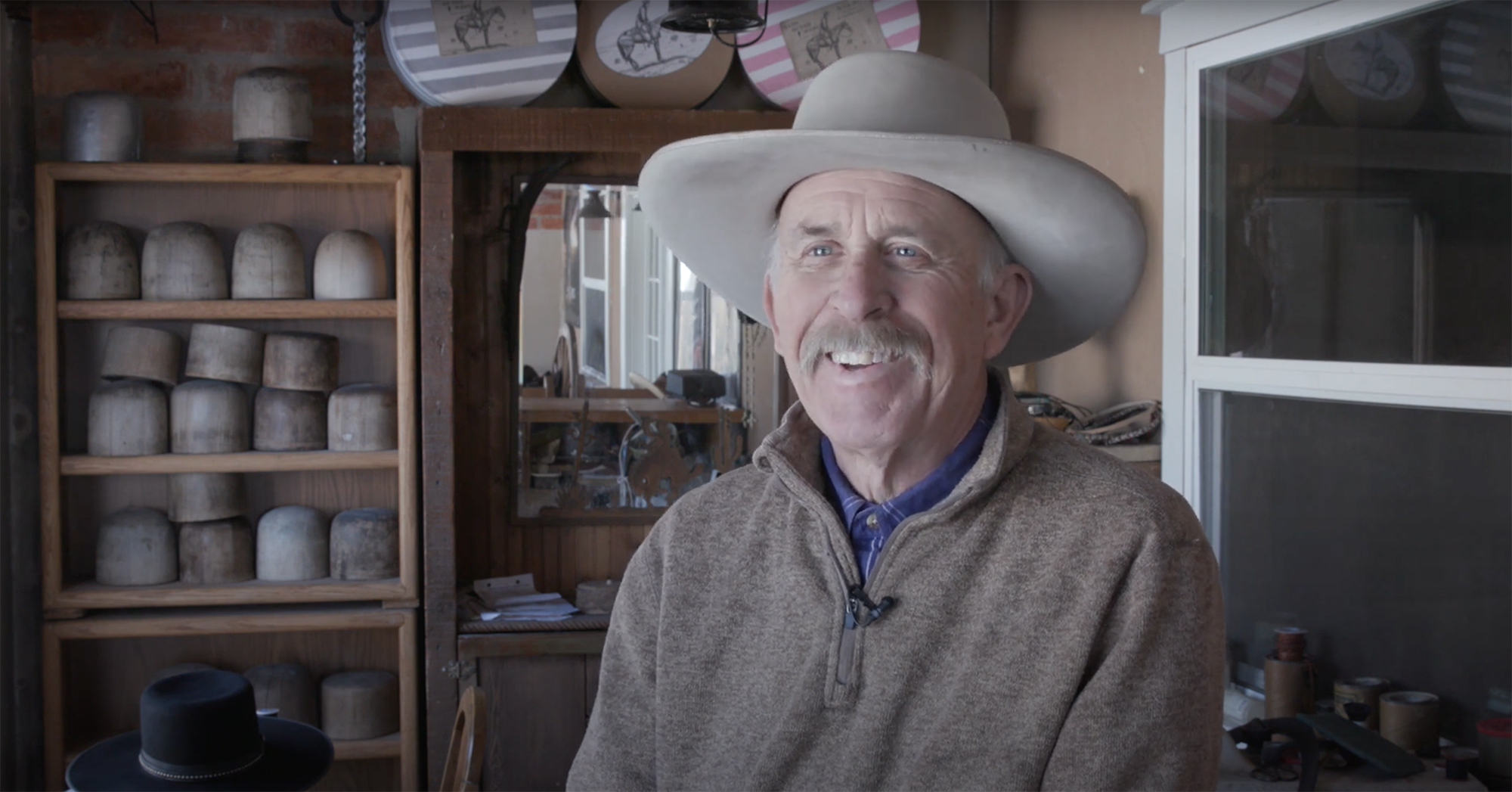
Tom Hirt was living his dream in the late 1970s, working as a double for such actors as Mark Harmon, Richard Farnsworth and Jason Robards in Comes a Horseman (1978) before an actors strike forced him to get a steady job. He wound up in a Colorado Springs, Colo., hat shop, later bought the business and started making hats for Western films, notably Tombstone (1993), but also Conagher (1991), The Quick and the Dead (1995), You Know My Name (1999) and many others. He also made hats for Ronald Reagan during the former actor’s presidency. Hirt’s still at it, not only making hats but also teaching others how to make them. He took time to talk hats and history from his home/ranch/workshop near Penrose, Colo.
How did you get started making Western hats?
They used to film a lot of movies around here. I got a call one day from Sam Elliott. I had done some hat work for some real low, low budget picture. Somehow he got my name, and he said, “I’d like to see you about a hat for a movie I’m going to make at Buckskin Joe” [an Old West theme park and town set used in films such as Cat Ballou (1965), The Cowboys (1972) and others]. He came out, and we talked about hats for a while, what he wanted his to look like, design and color, and he ordered a couple of pure beaver hats, and then a few weeks later he came out again for his hats, and the producer and the director came out together, so I got myself wrapped up in that picture [Conagher].
How many starring hats have you made for Elliott?
I can’t remember the order, but Sam did You Know My Name [1999], about Bill Tilghman. Then he did one where he was a sheriff, and a guy and girl stole something [1994’s The Desperate Trail]. Then he did Rough Riders [1997], about the Spanish-American War. He called me up and got me on board all of those and other ones doing hats. I also got to know [actor] Buck Taylor, which didn’t hurt at all.
I talk to Sam and thank him every single time. Without Sam Elliott, nothing would have happened.
‘Without Sam Elliott, nothing would have happened’
How did you get on Tombstone?
Sam called. “I’m doing a picture in southern Arizona called Tombstone,” he said. “I gave your name to the proper people, and they’ll be calling you. This is not something for me. I gave your name because you’ve done good things for me, but this is going to be a big job. Are you going to be capable of doing this? I want you to do it, but I don’t want you to be overwhelmed.” I didn’t know how demanding it was, but I said I can do it, and I did it.
I got calls from Taylor, Elliott, all these characters, and we’d talk about kinds of hats. And I got a call from Kevin Jarre, the director. He wanted to explain to me what he wanted to see. He told me some books he was looking at—[Frederic] Remington, [Charlie] Russell—the styles, some photographs he wanted me to look at of old cowboys.
So I got on board, went to Tucson. Twelve years later I left. I spent a year doing that picture.
How authentic were hats in Tombstone?
I think they were pretty authentic. I met a guy in Tucson after that movie hit the screen. He was from Hollywood. He says to me: “Tombstone may not be one of the best Westerns ever made, but it was a good Western. But for wardrobe and costume that was the first Western I’d seen where you had a Victorian man and a Victorian woman dressed in Victorian clothes. You had cowboys who were dressed as cowboys. City people living in town dressed as city people would have dressed.” They had clothing for their lifestyle. Up until then you’d find the guy who runs the general store in town having a cowboy hat on. You’d find a woman wearing a dress that was not of the era, because it was fashionable.
‘Everything is done by hand. That puts me way out of the modern world. I still do all the work’
When did hat making change and become big business?
Back then everybody was a custom hatmaker. Every town had a hat shop. But then [John B.] Stetson started making hats for the world. He made a hat of a better quality, which made him famous. You could buy a hat in Santa Fe and buy the same hat in San Francisco. He shipped all over the country. That’s what changed the hat industry [after the Civil War].
Other companies came along, making hats, shipping them all over the country, and the custom hatmaker fell out of favor. What do we need a custom hatmaker for? Jack Kennedy stopped wearing hats, so what do we need hats for? There were only cowboy hats in the movies, because nobody was wearing fedoras back East.
But then I ran into Art Henderson [late owner of Weather Hat Shop in Colorado Springs], who taught me the business, which I bought. I had a custom hat shop.

You make custom hats largely by hand. Is it an art?
Yes, it is an art. When you consider that this is all hand-sewn. What’s hand-sewn today? I use an old 65- to 70-year-old Singer featherweight sewing machine to put the bound edge on a hat. I don’t have a flanging machine. I don’t have a blocking machine. Everything is done by hand. That puts me way out of the modern world. I still do all the work.
So when it came time to teach hat making, I knew how to do all the stuff by hand. How did guys do it in the 1880s, the 1850s? They had to do it by hand. Maybe they had a steam boiler to create steam for their hat shop, but everything was done by hand. So that’s the way I do it. One piece at a time. One customer at a time. It’s slow, and I think that people don’t realize, when you’re doing it one piece at a time, how slow it can be.
Just how slow is that?
When I get to the hat, it takes a week. It’s like buying a pair of boots. It’s got to be put on a last [hat block], and then it’s got to sit on that last for a week. I don’t have a machine that irons and presses it. Then I have to let it sit on a flange for a day or two days, and then I have to sew it together—usually in the morning, sewing in the headband. I’ve been doing that forever. It’s simple, but if you don’t know it, it’s complicated.
Were hat crowns in the Old West shaped by hatmakers or by cowboys as they broke them in?
I think there was a combination. Hatmakers knew they could shape a hat any way they wanted to, so they would be creative about it. But I know that early Western hats were shaped more by the style that was going around. You could almost spot a guy by the shape of his hat and say, “Oh, he’s from northern Texas or southern Texas or California or Colorado,” because of the shape of the hat. It had a certain look to it that was conducive to a certain area of the country. Not so much like that anymore. Too much to pick from.
What prompted you to teach hat making?
I got asked if I would teach a hat making class at Trinidad [Colorado] State College. The dean asked me. Turnout was great. Interest was really incredible. For six years now I’ve been doing classes, except for this past year, when everything was canceled because of COVID.
I’m teaching at Ghost Ranch [in Abiquiu, N.M.], at Stitchology [in Albuquerque, N.M.] and at Mescal [the Arizona set for Tombstone].
What period of cowboy hats do you like most?
That is a question nobody has ever asked me. That’s cool. I’ve done them all, but you know, if I was going to go back to a period, maybe right after the 20th century to 1920, 1930. Hats were of a better quality. They looked better.
What do you think of most hats in Western movies?
The hats were a lot cooler when Gary Cooper was making Westerns. Look at Gary Cooper in The Westerner [1940] or in Along Came Jones [1945], before they started wearing the uniform of Hollywood—which was a little, narrow-brimmed hat all the same shape, like the Cartwrights [in Bonanza]—the crappiest looking hats in the era of the later B Westerns, the later television series. They didn’t have any nostalgia. They all looked like little fedoras, with a curl on the brim instead of a snap brim. But if you look at those early Westerns, they had a lot of nice style hats. Watch the characters on the street—not the stars, but the extras—they wore better looking hats than what the actors wore, because they were real, real hats. They weren’t made for a Hollywood image. WW





